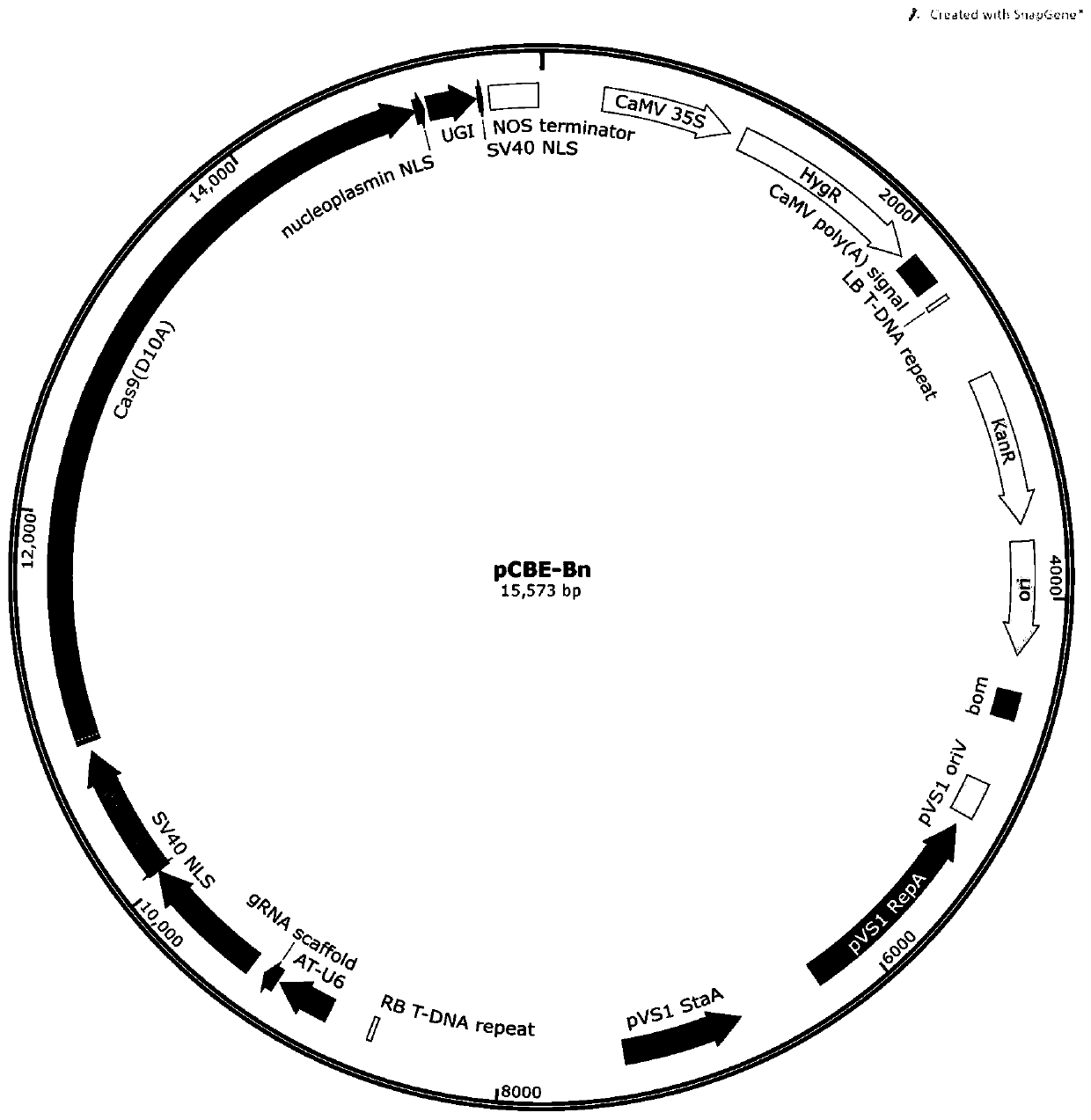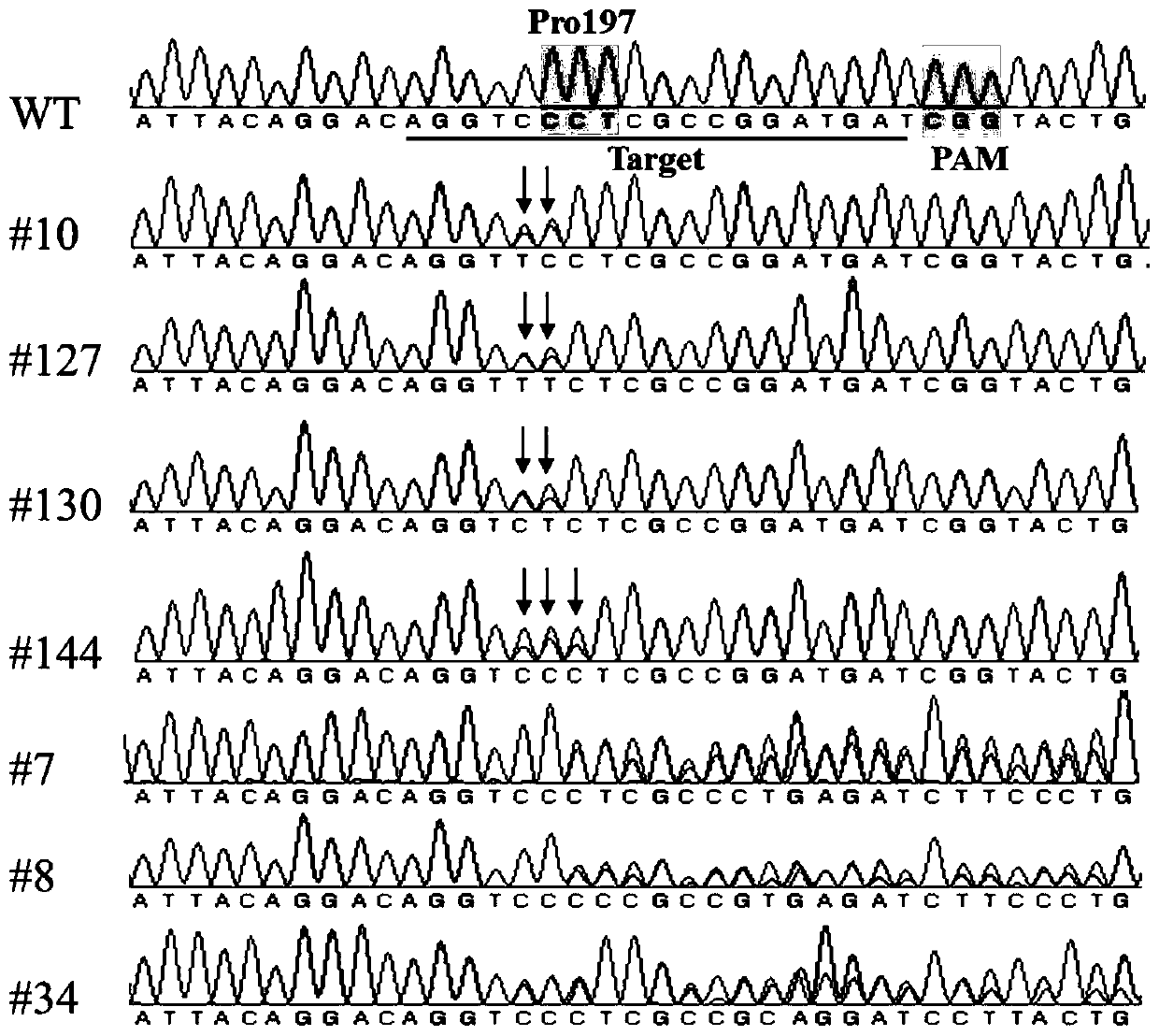BnALS1 mutant gene and protein based on gene editing and application of BnALS1 mutant gene and protein
A mutation-type, base-editing technology, which is applied in the fields of application, genetic engineering, and plant gene improvement, can solve the problems of low gene site-directed mutation efficiency and lack of base-editing technology, and achieve the effect of enriching germplasm resources
- Summary
- Abstract
- Description
- Claims
- Application Information
AI Technical Summary
Problems solved by technology
Method used
Image
Examples
Embodiment 1
[0039] Example 1 Construction of cytosine base editing vector
[0040] The cytosine base editing vector pCBE-Bn suitable for dicotyledonous plants such as rape provided by the present invention is constructed based on the pCAMBIA1300 vector ( figure 1 ). First, we synthesized the DNA sequence (as shown in SEQ ID NO: 1) at Shanghai Sangon Biotech, including U6 promoter, sgRNA expression cassette, ubiqintin1 promoter, nos terminator and other elements. The pCAMBIA1300 vector was digested with HindIII and Acc65I, and then the digested vector was ligated with the synthetic DNA sequence to obtain an intermediate vector. Using rice base editing vector pH-nCas9-PBE (Addgene: #98164) as template, B-NcoI-F (GAAACACAAA CCATGC CAAAGAAGAAGAGGAAGGTT) and BE-BamHI-R (CGATCAATCA GGATCC CTACACCTTCCGCTTCTTCTTTG) is a primer to amplify the rAPOBEC1-nCas9-UGI element sequence therein. The intermediate vector was digested with BamHI and NcoI and the rAPOBEC1-nCas9-UGI amplified fragment was...
Embodiment 2B
[0042] Example 2 Construction and genetic transformation of BnALS1 editing vector
[0043] The sequence information of the wild-type BnALS1 gene was obtained from the European winter rape variety Darmor-bzh reference genome database (http: / / www.genoscope.cns.fr / brassicanapus / ). Combining the known herbicide resistance site information and the target site information designed by CRISPR-P2.0 software (http: / / crispr.hzau.edu.cn / CRISPR2 / ), it was found that there is a suitable one at the Pro197 site Target site AGGTCCCTCGCCGGATGAT.
[0044] By synthesizing the following primers sgRNA-F and sgRNA-R with adapters and annealing, the rapeseed base editing vector obtained in Example 1 was digested with BsaI, and then the target site was ligated into the sgRNA by conventional fragment carrier ligation expression cassette. The specific method is as follows:
[0045] (1) Primer sequence:
[0046]
[0047] (Deepened bases are linker sequences)
[0048] (2) Primer annealing:
[004...
Embodiment 3
[0081] Positive identification and edit detection of embodiment 3 tissue culture seedlings
[0082] After the regenerated seedlings of Example 2 were transplanted into the soil for normal production, the young leaves were taken to extract genomic DNA using the 2% CTAB method. Subsequent PCR positive detection was performed using vector-specific primers M13F (GGTAACGCCAGGGTTTTCC) and sgRNA-R2 (GCCATTTGTCTGCAGAATTG). A total of 217 positive plants were found in 230 tissue culture seedlings, and the positive rate was 94.3%. It shows that the rapeseed transgenic system used in the present invention is relatively perfect.
[0083]Then we performed editing detection on the obtained positive plants. Use BnALS1-specific primers WJP198F (TCGACAAGAACAAGACTTTCG) and WJP 198R (CACGGTCATCAAACCTAACAC) to carry out PCR amplification, and then the amplified products are directly subjected to Sanger sequencing. According to the sequencing profile, we found that a total of 7 plants of the T0...
PUM
| Property | Measurement | Unit |
|---|---|---|
| Length | aaaaa | aaaaa |
Abstract
Description
Claims
Application Information
 Login to View More
Login to View More - R&D
- Intellectual Property
- Life Sciences
- Materials
- Tech Scout
- Unparalleled Data Quality
- Higher Quality Content
- 60% Fewer Hallucinations
Browse by: Latest US Patents, China's latest patents, Technical Efficacy Thesaurus, Application Domain, Technology Topic, Popular Technical Reports.
© 2025 PatSnap. All rights reserved.Legal|Privacy policy|Modern Slavery Act Transparency Statement|Sitemap|About US| Contact US: help@patsnap.com



